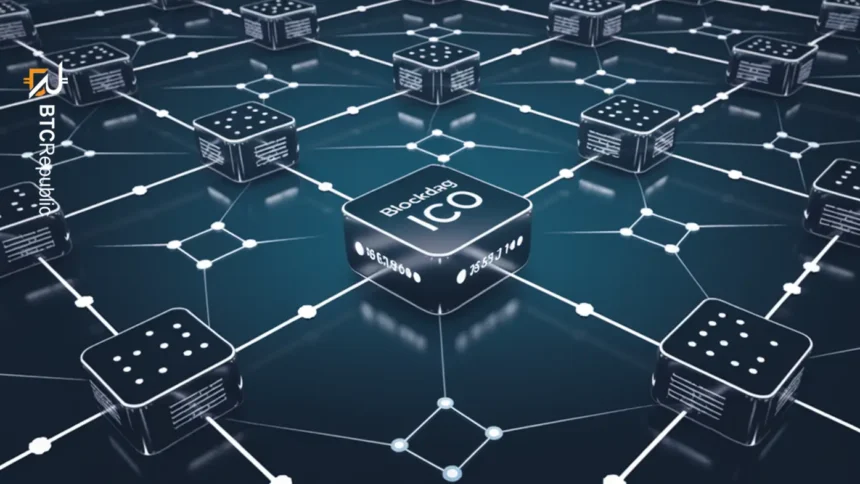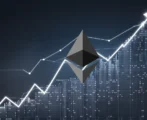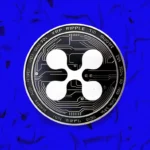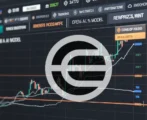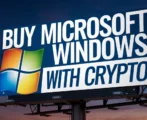ICOs are a constant feature of the trendy cryptocurrency market. They often attract a significant level of excitement and hype.
Some, such as Block.one (EOS) and Telegram (TON) were hugely successful, raising billions of dollars in a relatively short time. However, many ICOs have also failed to generate even a single dollar.
Additionally, many tokens that manage to raise ICO money often end up not being as successful as anticipated or fail. However, many also become successful, which is why ICOs continue to pique the interest of investors who are always on the lookout for the next big ROI potential.
Could that be BlockDAG? What is BlockDAG? How does it work? Why is it generating palpable excitement in the crypto industry?
What Is BlockDAG?
BlockDAG is a Bitcoin and Kaspa-inspired layer one (L1) blockchain protocol that uses a directed acyclic graph (DAG) structure and a hybrid Proof of Work (PoW) consensus mechanism.
Its unique features aim to address the dilemma associated with decentralization and ensure robust security, fast transaction speeds, enhanced scalability, and overall efficiency.
As noted above, the protocol is still in its early phases.
BlockGAD can be likened to a faster upgrade of the slower Bitcoin, albeit its technology is more similar to that used by Kaspa but with some differences.
Additionally, BlockDAG is compatible with EVM, meaning that developers can leverage it for seamless cross-chain migration of their dApps and smart contracts, provided the chains involved are all EVM-compatible.
In summary, think of BlockDAG as a hybrid project – a combination of the more secure and trusted features of traditional blockchains and the scalability and speed of directed acrylic graph systems.
It is this hybrid strategy that enables BlockDAG to securely process a much larger volume of transactions per second than conventional blockchain networks.
By aiming to resolve the limitations inherent in both DLT technologies, BlockDAG is trying to ensure that future DLTs scale to cope effectively with the constantly increasing demands of the crypto industry and other digital assets enthusiasts.
BlockDAG was introduced in 2023 by a team led by Antony Turner. Its native coin is known as BDAG. There are a total of 150 billion BDAG coins in supply, and a BDAG halving process is held once a year.
How Directed Acrylic Graphs Work
Although both traditional blockchains and DAGs can offer decentralized digital transaction solutions, significant differences exist in the structure and functional makeup of each technology.
A traditional blockchain is characterized by a linear chain of blocks, with each block linked to the block preceding it in a sequential arrangement or order.
In contrast, DAG uses a parallel transaction processing model, which makes it possible to confirm transactions simultaneously so that multiple blocks can be processed concurrently.
This unique web-like architecture (shown below) has a number of benefits, such as improved transaction throughput, enhanced scalability, and greater overall efficiency.
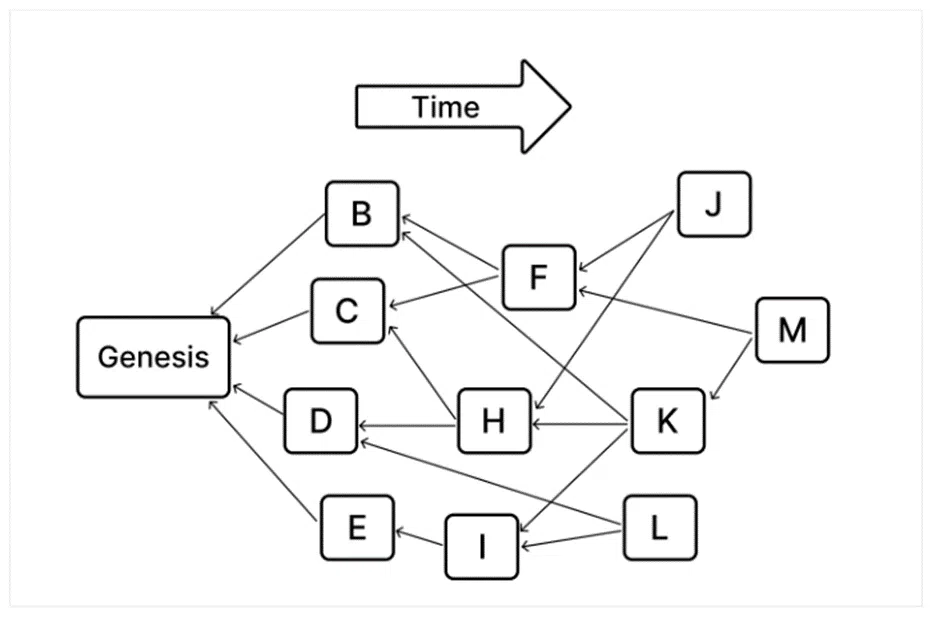
However, though DAG systems are built with considerable security features, processing blocks simultaneously still present them with unique security concerns.
For instance, an increased possibility of attack vectors or incorporating blocks from adversaries. Another challenge is evolving a way to sequence transactions accurately via linear ordering.
These challenges probably explain why BlockDAG has chosen to combine features from both DAGs and traditional blockchains.
BlockDAG ICO Presales
BlockDAG’s BDAG presale has been going on since March 2024. The presale has 45 batches, and the coin price will increase gradually after each batch.
So far, there have been 22 stages that have raked in $70 million as of September 6, 2024, a clear signal of the interest BDAG is attracting in the market. Around 12.7 billion BDAG coins have already been sold within this period.
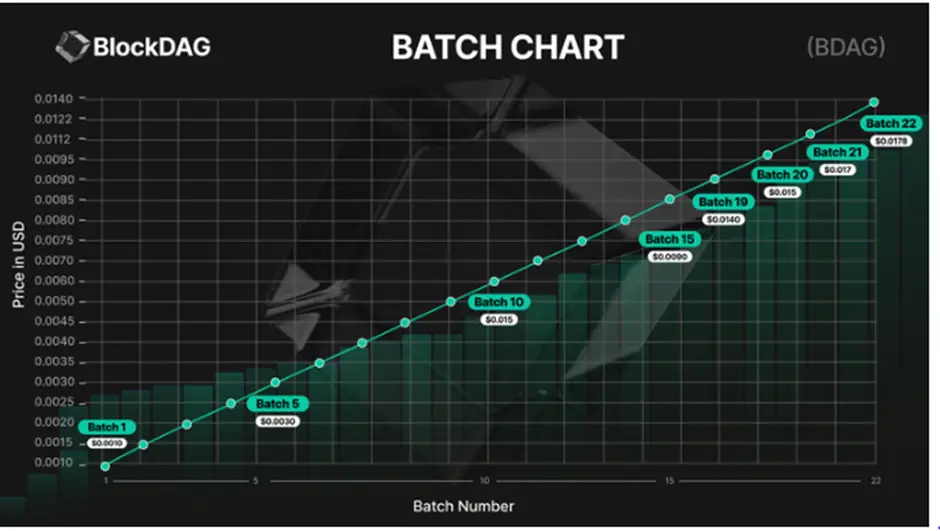
The success of the presale exercise seems to have helped galvanize the coin to a remarkable 1680% price appreciation – from $0.0011 initially to $0.0178 as of September 3, 2024.
BlockDAG’s forthcoming test net launch on September 20, 2024, could create even more buzz.
There are bullish sentiments that BDAG’s price could rise to a dollar after it goes public. This optimism mainly arises from a solid technological base and growing support.
Notably, BlockDAG has come up with rank-based automatic bonuses that reward investors according to their rank.
The ranking, which is creating excitement among crypto enthusiasts, is themed after ocean animals – from Whales down to Turtles. The higher you rank, the bigger your bonus. For example, Turtles get a 2% bonus, while Whales get 8%.
How To Buy BDAG Coins
As noted above, BlockDAG is still a very young project, so its coins have not yet been publicly offerred. Hence, the only way to acquire them for now is through the BDAG mining or presale programs.
To mine BDAG, purchase any of BlockDAG’s X-series miners (X1, X10, X30, and X100).
To buy through the presale program:
- sign in to the BlockDAG presale website using a crypto wallet that supports Wallet Connect (BlockDAG recommends MetaMask for those using a desktop browser and either Plus Wallet or Trust Wallet for other users).
- Click on the ‘’Buy’’ option.
- Link your wallet.
- Select a payment method and proceed.
After completing your presale purchase, your BDAG coins will likely arrive via an airdrop, which involves an automatic delivery of the coins directly into the buyer’s wallet.
BDAG coins can be purchased with a variety of cryptos, including BTC, KASPA, BNB, Ethereum, DOGE, SHIB, XRP, SOLANA, Cardano, Fantom, USDT (Eth Network), and USDT (TRON Network).
Conclusion
BlockDAG is a promising blockchain project that is still in its ICO stages. Its combination of DAG and traditional blockchain technologies is helping it to attract significant interest from investors and other crypto enthusiasts.
But until it becomes a mainnet, enters the market, and competes with rivals, nobody can say with certainty how successful it will be.
FAQs
-
What is BlockDAG’s speed?
Presently, BlockDAG can process 10 blocks every second, but its developers are planning to ramp this up to over 100 blocks in the future.
-
Are there any other crypto blockchains that use DAG?
Yes. Some of them include KASPA (KAS), IOTA (MIOTA), OByte (GBYTE), Hedera Hashgraph (HBAR), Fantom (FTM), and Nano (XNO).
-
What is BlockDAG’s relationship with KASPA?
Though BlockDAQ shares the same technological foundation with Kaspa, it has modified and enhanced its blockchain according to its specific objectives and goals.


